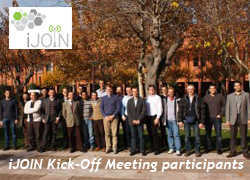IMDEA Networks

Event Category: In-house Presentation
An Economic Side-Effect for Prefix Deaggregation
The injection of artificially fragmented prefixes through BGP is a widely used traffic engineering technique. In this paper we examine one particular economic side-effect of deaggregation, namely the impact on the transit traffic bill. We show that the use of more-specific prefixes has a traffic stabilization side-effect which translates into a decrease of the transit traffic bill. We propose an analytical model in order to quantify the impact of deaggregation on the transit costs. We validate our results by means of simulations and through the extensive analysis of real BGP routing information data.
Seguir leyendo arrow_right_altRate Allocation for Layered Multicast Streaming with Inter-Layer Network Coding
Rate Allocation for Layered Multicast Streaming with Inter-Layer Network Coding Abstract Multi-layer video streaming allows to provide different video qualities to a group of multicast receivers with heterogeneous receive rates. The number of layers received determines the quality of the decoded video stream. For such layered multicast streaming, network coding provides higher capacity than multicast routing.
Seguir leyendo arrow_right_altContention resolution and packet queuing on a multiple access channel
Dr. Kowalski will present recent advances on contention resolution and packet queuing on a multiple access channel. His will include description of algorithms, both already known and newly developed, accompanied by theoretical analysis of queue sizes and latency. He will conclude with showing and elaborating on selected simulation results that support theoretical formulas.
Seguir leyendo arrow_right_altNetwork-based Distributed Mobility Management Demo
The number of mobile users and their traffic demand is expected to be ever-increasing in future years, and this growth can represent a limitation for deploying current mobility management schemes that are intrinsically centralized, e.g., Mobile IPv6 and Proxy Mobile IPv6. For this reason it has been waved a need for distributed and dynamic mobility management approaches, with the objective of reducing operators' burdens, evolving to a cheaper and more efficient architecture.
Seguir leyendo arrow_right_altVoIPiggy: Implementation and evaluation of a mechanism to boost voice capacity in 802.11 WLANs
Supporting voice traffic in existing WLANs results extremely inefficient, given the large overheads of the protocol operation and the need to prioritize this traffic over, e.g., bulky transfers. In this paper we propose a simple scheme to improve the efficiency of WLANs when voice traffic is present.
Seguir leyendo arrow_right_altiJOIN: Interworking and JOINt Design of an Open Access and Backhaul Network Architecture for Small Cells based on Cloud Networks
This is the kick-off meeting of the iJOIN EU FP7 project. It will consist of a series of presentations of work packages 2-4 intended to shape the first steps of the project. WP2-4 will be presented during 90 minute slots by each Work Package leader.
Seguir leyendo arrow_right_altEnergy Consumption Anatomy of 802.11 Devices and its Implication on Modeling and Design
A thorough understanding of the power consumption behavior of real world wireless devices is of paramount importance to ground energy-efficient protocols and optimizations on realistic and accurate energy models. This paper provides an in-depth experimental investigation of the per-frame energy consumption components in 802.11 Wireless LAN devices. To the best of our knowledge, our measurements are the first to unveil that a substantial fraction of energy consumption, hereafter descriptively named cross-factor, may be ascribed to each individual frame while it crosses the protocol/implementation stack (OS, driver, NIC). Our findings, summarized in a convenient new energy consumption model, contrast traditional models which either neglect or amortize such energy cost component in a fixed baseline cost, and raise the alert that, in some cases, conclusions drawn using traditional energy models may be fallacious.
Seguir leyendo arrow_right_altLow-Complexity Visible Light Networking with LED-to-LED Communication
Visible Light Communication (VLC) is an emerging technology in which Light Emitting Diodes (LEDs) transport information wirelessly, using the visible light spectrum. While most of the research on VLC has focused on wideband white LEDs used in ambient illumination, narrowband and colored LEDs have received little attention. Short-range free-space optical communication based on narrowband LEDs as visible light transmitters and receivers enable a variety of applications, a scenario we refer as LED-to-LED communication. In this work, we introduce the communication and networking protocols of LED-to-LED communication. Our work addresses fundamental challenges such as efficient collision detection medium access protocol and elimination of light flicker. We build a prototype and demonstrate bi-directional data exchange in a network of up to four LEDs. We further study the trade-offs in the system design and measure the achievable bit-rate and transmission distances
Seguir leyendo arrow_right_altTowards a Next Generation Internet Architecture
The international networking research community has begun to focus on ideas for a next generation Internet architecture. Before developing a next generation architecture, however, it seems appropriate to understand what exactly the problems are with the current Internet architecture. There seems to be widespread agreement that mobility and security are the primary problems stressing the current Internet, but exactly what the problems with mobility and security are, and in particular, whether the problems are architectural in nature, is under dispute. In this lecture series, we examined the mobility and security with the intention of understanding the current architecture and what might be done for a next generation architecture.
Seguir leyendo arrow_right_alt“Research Trends in Future Internet”, Telefonica Open Research Day 2008
Telefonica Open Research Day 2008
Research is the process of exploration of new ideas and allows Telefonica to look into the future, working on tomorrow's problems and finding solutions that people can only dream about today.
As a result Telefonica is investing in bringing together incredibly passionate talented people with different view points (nationalities, disciplines, backgrounds) to follow their dreams, create new subjects and as a result new worlds for Telefonica's customers.
Seguir leyendo arrow_right_alt











Comentarios recientes